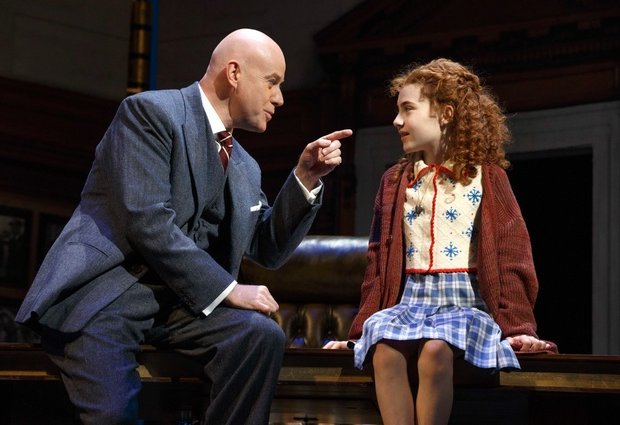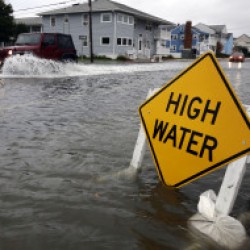I review the new Broadway revival of Annie in today’s Wall Street Journal. Very much to my surprise, I loved it. Here’s an excerpt.
* * *
 Annie is dead–but “Annie” lives. Two years after Harold Gray’s long-running comic strip about a plucky orphan child finally breathed its last, the perennially popular 1976 stage version of “Little Orphan Annie” is back on Broadway for the third time. For anyone surprised that the musical responsible for inflicting “Tomorrow” on the world has proved to have that kind of staying power, here’s an even bigger surprise: This revival of “Annie” is fabulous. Creatively staged by James Lapine, Stephen Sondheim’s longtime collaborator, and smartly cast from top to bottom, it makes a convincing case for a musical widely regarded by cynical adults as suitable only for consumption by the very, very young. Even if you’re a child-hating curmudgeon, you’ll come home grinning in spite of yourself.
Annie is dead–but “Annie” lives. Two years after Harold Gray’s long-running comic strip about a plucky orphan child finally breathed its last, the perennially popular 1976 stage version of “Little Orphan Annie” is back on Broadway for the third time. For anyone surprised that the musical responsible for inflicting “Tomorrow” on the world has proved to have that kind of staying power, here’s an even bigger surprise: This revival of “Annie” is fabulous. Creatively staged by James Lapine, Stephen Sondheim’s longtime collaborator, and smartly cast from top to bottom, it makes a convincing case for a musical widely regarded by cynical adults as suitable only for consumption by the very, very young. Even if you’re a child-hating curmudgeon, you’ll come home grinning in spite of yourself.
What makes this “Annie” so special is that Mr. Lapine, who claims never to have seen the show prior to directing this production, decided to approach it not as an exercise in neon-lit nostalgia but as a hard-headed fable about life in the Great Depression. His Annie (Lilla Crawford) has a side-of-the-mouth Brooklyn-style accent, while Miss Hannigan (Katie Finneran), who runs the orphanage-sweatshop on whose doorstep Annie’s parents left her, is a nasty, drunken slut. And while the second act remains relentlessly optimistic–it couldn’t very well be anything else–Mr. Lapine has also succeeded in endowing the relationship between Annie and Daddy Warbucks (Anthony Warlow), the tough-guy tycoon who adopts her, with wholly credible emotion.
That last twist is the most striking aspect of Mr. Lapine’s staging, and his stars deserve great credit for bringing it to fruition. The eleven-year-old Ms. Crawford’s voice is (if I may resort to euphemism) penetrating, but she has more than enough acting talent to compensate for the undeniable fact that she sings REALLY LOUD. As for Mr. Warlow, an Australian musical-theater performer with extensive operatic experience, he’s destined for stage stardom. Not only does he sing “Something Was Missing,” his solo number, with bewitching finesse–vocal connoisseurs will be dazzled by his skillful use of head voice–but he acts as well as he sings….
* * *
Read the whole thing here.
An interview with James Lapine and Andy Blankenbuehler, the director and choreographer of Annie:
Archives for November 9, 2012
TT: Keeping it personal
In today’s Wall Street Journal “Sightings” column I look at how artists respond to great public events like Hurricane Sandy–and how amateurs sometimes do a better job. Here’s an excerpt.
* * *
Here’s a safe bet: The e-mailboxes of every editor at every publishing house in Manhattan are filling up with proposals for novels about Hurricane Sandy. And here’s a safer one: If any of them actually get written, they’ll be awful.
 Artists of all kinds have a weakness for Big Statements. But few of them are equal to a challenge the size of Sandy, which laid waste to much of the eastern seaboard. Consider the art created in response to 9/11. Was any of it good? Truth to tell, just about all of it is already forgotten, and rightly so. Novelist Jonathan Safran Foer’s “Extremely Loud and Incredibly Close,” classical composer John Adams’ “On the Transmigration of Souls,” singer-songwriter Neil Young’s “Let’s Roll,” sculptor Eric Fischl’s “Tumbling Woman”: All now seem hopelessly inadequate to the task of embodying such an event, much less clarifying its human impact….
Artists of all kinds have a weakness for Big Statements. But few of them are equal to a challenge the size of Sandy, which laid waste to much of the eastern seaboard. Consider the art created in response to 9/11. Was any of it good? Truth to tell, just about all of it is already forgotten, and rightly so. Novelist Jonathan Safran Foer’s “Extremely Loud and Incredibly Close,” classical composer John Adams’ “On the Transmigration of Souls,” singer-songwriter Neil Young’s “Let’s Roll,” sculptor Eric Fischl’s “Tumbling Woman”: All now seem hopelessly inadequate to the task of embodying such an event, much less clarifying its human impact….
Who, then, will best tell posterity what it was like to be on the receiving end of Sandy? If I had to guess, I’d look to the innumerable photographers–most of them point-and-shoot amateurs–who have spent the last couple of weeks sharing images of the storm and its aftermath on Flickr and Instagram. Their snapshots are anything but slick. All they show is how things looked: Refrigerators in front yards, uprooted trees and caved-in roofs, flooded tunnels, darkened houses on the edge of collapse, and water everywhere. Naïve? Sure, but that’s what makes them so telling. Another way of describing them is unpretentious. Such photos are properly modest in the face of the nightmare that is a natural disaster. Instead of preaching a sermon, they invite you to look–and despair….
* * *
Read the whole thing here.
TT: Almanac
“‘The best thing for being sad,’ replied Merlyn, beginning to puff and blow, ‘is to learn something. That is the only thing that never fails. You may grow old and trembling in your anatomies, you may lie awake at night listening to the disorder of your veins, you may miss your only love, you may see the world about you devastated by evil lunatics, or know your honour trampled in the sewers of baser minds. There is only one thing for it then–to learn. Learn why the world wags and what wags it. That is the only thing which the mind can never exhaust, never alienate, never be tortured by, never fear or distrust, and never dream of regretting.'”
T.H. White, The Once and Future King
